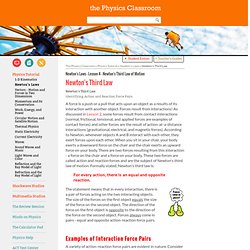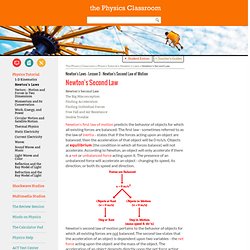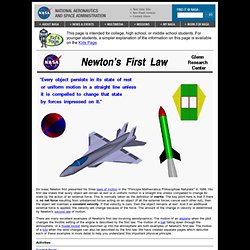

Newton's Third Law. A force is a push or a pull that acts upon an object as a results of its interaction with another object.

Forces result from interactions! As discussed in Lesson 2, some forces result from contact interactions (normal, frictional, tensional, and applied forces are examples of contact forces) and other forces are the result of action-at-a-distance interactions (gravitational, electrical, and magnetic forces). According to Newton, whenever objects A and B interact with each other, they exert forces upon each other. When you sit in your chair, your body exerts a downward force on the chair and the chair exerts an upward force on your body. There are two forces resulting from this interaction - a force on the chair and a force on your body. For every action, there is an equal and opposite reaction. The statement means that in every interaction, there is a pair of forces acting on the two interacting objects.
Examples of Interaction Force Pairs Consider the flying motion of birds. 1. 2. 3. Newton's Second Law. Newton's first law of motion predicts the behavior of objects for which all existing forces are balanced.

The first law - sometimes referred to as the law of inertia - states that if the forces acting upon an object are balanced, then the acceleration of that object will be 0 m/s/s. Objects at equilibrium (the condition in which all forces balance) will not accelerate. According to Newton, an object will only accelerate if there is a net or unbalanced force acting upon it. The presence of an unbalanced force will accelerate an object - changing its speed, its direction, or both its speed and direction.
Newton's second law of motion pertains to the behavior of objects for which all existing forces are not balanced. Newton's second law of motion can be formally stated as follows: The acceleration of an object as produced by a net force is directly proportional to the magnitude of the net force, in the same direction as the net force, and inversely proportional to the mass of the object. 1. Newton's First Law of Motion. Sir Isaac Newton first presented his three laws of motion in the "Principia Mathematica Philosophiae Naturalis" in 1686.

His first law states that every object will remain at rest or in uniform motion in a straight line unless compelled to change its state by the action of an external force. This is normally taken as the definition of inertia. The key point here is that if there is no net force resulting from unbalanced forces acting on an object (if all the external forces cancel each other out), then the object will maintain a constant velocity. If that velocity is zero, then the object remains at rest. And if an additional external force is applied, the velocity will change because of the force.
There are many excellent examples of Newton's first law involving aerodynamics. Activities: Guided Tours Newton's Laws of Motion: Navigation .. Beginner's Guide Home Page. Newton's Laws of Motion. The motion of an aircraft through the air can be explained and described by physical principals discovered over 300 years ago by Sir Isaac Newton.

Newton worked in many areas of mathematics and physics. He developed the theories of gravitation in 1666, when he was only 23 years old. Some twenty years later, in 1686, he presented his three laws of motion in the "Principia Mathematica Philosophiae Naturalis. " The laws are shown above, and the application of these laws to aerodynamics are given on separate slides. Newton's first law states that every object will remain at rest or in uniform motion in a straight line unless compelled to change its state by the action of an external force.
The second law explains how the velocity of an object changes when it is subjected to an external force. F = m * a For an external applied force, the change in velocity depends on the mass of the object. The third law states that for every action (force) in nature there is an equal and opposite reaction. Newton's Three Laws of Motion. Newton's Three Lawsof Motion Let us begin our explanation of how Newton changed our understanding of the Universe by enumerating his Three Laws of Motion.
